The Stock Exchange is all about trading. Each week we do the following:
- Discuss an important issue for traders;
- highlight several technical trading methods, including current ideas;
- feature advice from top traders and writers; and,
- provide a few (minority) reactions from fundamental analysts.
We also have some fun. We welcome comments, links, and ideas to help us improve this resource for traders. If you have some ideas, please join in!
Review:
Our previous Stock Exchange asked the question: Are You A Contrarian Trend Follower? After explaining that there is such a thing as a contrarian trend follower (as contradictory as it may sound), we considered how it can work strongly in your favor. A glance at your news feed will show that the key points remain relevant.
This Week: How Do You Allocate Your Trade Risk Budget?
According to an excellent article by Peter Way (The Wall Street Poker Table), playing the market is neither an art nor a science, but rather similar to a game of poker where the results depend, in part, on other players actions that are out of your control. Peter explains one thing that is certain, however, is an occasional loss. No one wins every hand of poker, and no one wins every trade. The question for market participants, is how will you allocate your risk budget? If time is a high cost for you, then you might consider a passive strategy instead of active one.
And if you are going to consider an active strategy, then there are lots of ways to allocate your trading risk budget. For example, Corey Hoffstein does an excellent job of explaining three categories of how traders may spend their risk budget in this article:
Corey explains the “What” is asset diversification. Specifically, what asset class are you going to invest in? Stocks?… bonds?… tulips? The “How” is process diversification. For example, are you going to make decisions based on value or momentum? (Corey shares data on the attractiveness of momentum / trend following strategies). And the “When” is “timing luck.” At first, the word luck may sound unimpressive. However, it’s actually quite insightful, in our view, because it deals with the important (but often overlooked) concept of “what opportunities is the market providing at the time of rebalancing?” Very astute concept by Corey.
Further still, another useful concept when considering your trading risk budget is the importance of listening to your “internal dialogue” (i.e. “the self-talk that we engage in throughout our waking hours”). As usual, Dr. Brett Steenbarger’s article on internal dialogue is both fascinating and practical:
Of course “position sizing” and “knowing when to cut your losses” are two additional very important risk budgeting concepts to consider. In addition to position sizing and dynamic stop orders, our models also diversify across strategies and “timing luck,” to name just a few.
Model Performance:
Per reader feedback, we’re continuing to share the performance of our trading models.
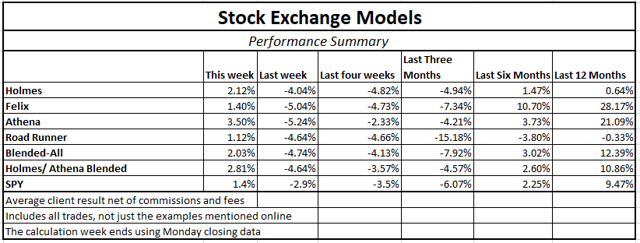
We find that blending a trend-following / momentum model (Athena) with a mean reversion / dip-buying model (Holmes) provides two strategies, effective in their own right, that are not correlated with each other or with the overall market. By combining the two, we can get more diversity, lower risk, and a smoother string of returns.
And for these reasons, I am changing the “Trade with Jeff” offer at Seeking Alpha to include a 50-50 split between Holmes and Athena. Current participants have already agreed to this. Since our costs on Athena are lower, we have also lowered the fees for the combination.
If you have been thinking about giving it a try, click through at the bottom of this post for more information. Also, readers are invited to write to main at newarc dot com for our free, brief description of how we created the Stock Exchange models.
Expert Picks From The Models:
This week’s Stock Exchange is being edited by Blue Harbinger; (a source for independent investment ideas).
Holmes: This week I like Yandex (NASDAQ:YNDX). It is an Internet search engine out of Russia.
Blue Harbinger: Interesting Holmes. Russia has been an important topic in the news lately for multiple reasons. Why do you like Yandex?
Holmes: Well as you know, I am a contrarian. And based on the following chart, you can see Yandex is providing quite a dip-buying opportunity.
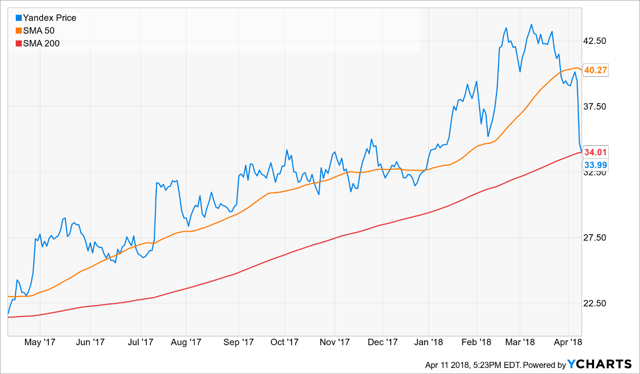
BH: Yes, I see the obvious dip, but that is certainly driven, in-part, by the news. I realize that Yandex’s revenues have been increasing dramatically in recent year, but aren’t you just a little bit nervous about the geopolitics?
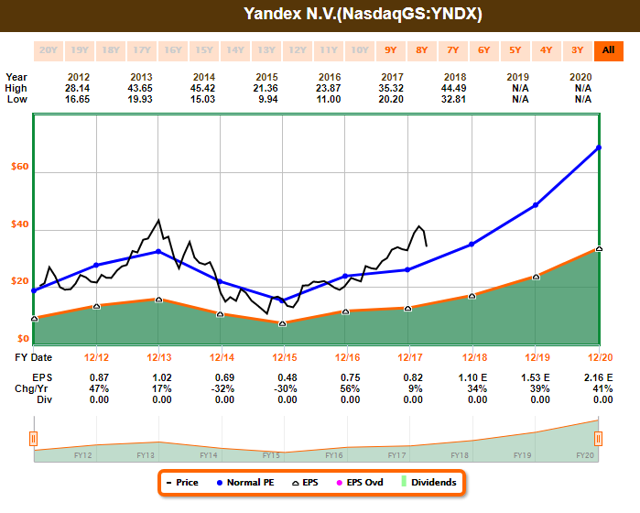
Holmes: I am a trading model, not a person. So no—I am not “nervous.” I typically hold my positions for about 6 weeks, and I generally exit when my price target is achieved.
BH: I have to admit, this is a tempting trade Holmes, and I appreciate you bringing it to my attention. However, unlike you—I am a human, and even though Yandex appears to be a healthy growing company, my nerves just won’t let me pull the trigger. I’ll be watching this trade closely.
Holmes: Objectively speaking, you’ll likely be sitting on the sidelines while I generate attractive profits. Anyway, how about you, Road Runner—any trades this week?
Road Runner: Yes, this week I like Burlington Stores (NYSE:BURL). Ever heard of it?
BH: Yes—it’s the old Burlington Coat Factory. I’m surprised you’re even considering a brick-and-mortar retailer. Apparently you trading models don’t watch the new because if you did you might be afraid that the Internet (e.g. Amazon (NASDAQ:AMZN)) is going to put all brick-and-mortar retailers out of business (and Holmes would be too concerned to even consider Yandex). Nonetheless, why do you like Burlington Stores, Road Runner?
RR: I am a trend follower, and I typically like to hold stocks for about 4-weeks. Check out the following chart, Burlington has some serious momentum.

BH: Yes, Burlington has some momentum. And even though your chart only goes back about a month, this stock’s momentum has been continuing a lot longer than that—arguably since the start of 2016 (with a few relatively small pullbacks). This is so shocking to me because most retailers are getting killed. However, if I look at the financials, revenues are growing, net income is growing, and the balance sheet isn’t terrible. Plus, they beat earnings expectations last month, gross margin improved, comps improved, and guidance is strong. Here is a look at the Fast Graph.

Road Runner: Thanks for the fundamentals, Blue Harbinger, but I am a trader, not an investor. I’ll be out of this trade in about 4-weeks, long-before the long-term fundamental story plays out.
BH: Thanks for sharing your Burlington trade, Road Runner. That retailer is an anomaly compared to the larger retail bloodbath narrative. Anyway, how about you, Felix—any trades this week.
Felix: Yep—I sold my Alnylam Pharmaceuticals (NASDAQ:ALNY) shares on April 4th. I bought them on February 16th, if you recall.

BH: Looks like this one didn’t go exactly your way, but as Peter Way explained earlier in this report—you can’t win them all. And I’ll certainly cut you some slack considering your 6 and 12-month track record is very strong, as shown in the performance table earlier in this report. Why’d you sell.
Felix: It hit one of our dynamic stop loss orders. You know, one of the whole “knowing when to cut your losses” thing that was mentioned earlier in this report when we were talking about “risk budgets.”
BH: Got it, Felix. Thanks for sharing. Do you have anything else for us.
Felix: Yes, here is a ranking of my top 20 stocks in the High Liquidity S&P Midcap.

BH: Interesting selection universe, Felix. Regardless, I like to know what you are “thinking,” so thanks for sharing these ideas. And how about you, Athena—any trades this week?
Athena: Yes. This week I bought Twitter (NYSE:TWTR) on April 9th. If you recall, I previously bought these shares during the week of February 22nd, I sold them in March, and I am rebuying them now at a lower price. What can I say—I am a trader. Here is a look at the charts.
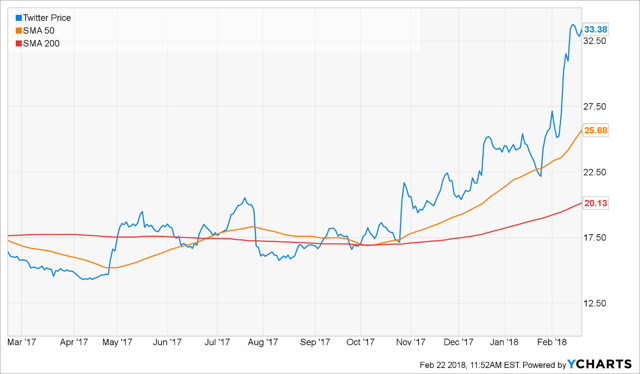
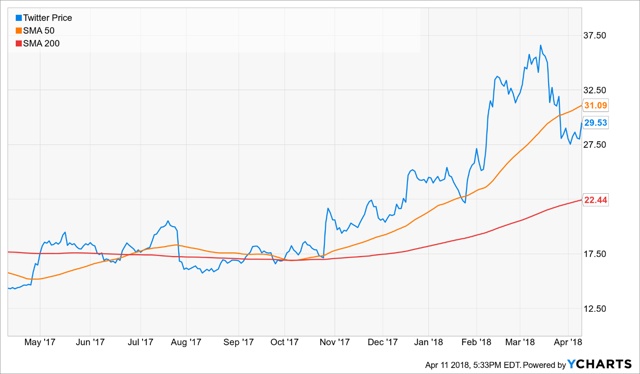
BH: It looks like you did alright with this one the last time around. Why do you like Twitter though?
Athena: Because, simply stated, I am a momentum trader. On average, I hold my positions for around 17-weeks, but I generally exit when my price target is hit or when my stops get activated.
BH: Okay. Well I’m not sure if I like that CEO, Jack Dorsey, splits his time between Twitter and Square (NYSE:SQ). Seems like an odd arrangement, and I question his focus. Seems like both positions require more time than he is giving. Anyway, how about you, Oscar—any trades?
Oscar: No trades to share, but I do have a ranking to share. The following table includes my top 20 ETFs from my comprehensive and diverse ETFs universe.

BH: Thanks for sharing, Oscar. I enjoy these rankings. Your ETF momentum style is interesting to me, especially considering you rotate to a new ETF every 6-weeks, on average.
Conclusion:
In poker, no one wins every hand; and in trading no one wins every trade. The key is to make more money on your winners than you lose on your losers. One way to improve your chances, or at least limit your losses, is the concept of “risk budgeting.” There are multiple ways to think about risk, and to budget your risk exposures. For example, we like to employ process diversification (across trend-following and dip-buying), position sizing, and knowing when to cut losses (stops), to name just a few. How do you budget your risk exposures?
Background On The Stock Exchange:
Each week, Felix and Oscar host a poker game for some of their friends. Since they are all traders, they love to discuss their best current ideas before the game starts. They like to call this their “Stock Exchange.” (Check out Background on the Stock Exchange for more background). Their methods are excellent, as you know if you have been following the series. Since the time frames and risk profiles differ, so do the stock ideas. You get to be a fly on the wall from my report. I am usually the only human present and the only one using any fundamental analysis.
The result? Several expert ideas each week from traders, and a brief comment on the fundamentals from the human investor. The models are named to make it easy to remember their trading personalities.

Getting Updates:
Readers are welcome to suggest individual stocks and/or ETFs to be added to our model lists. We keep a running list of all securities our readers recommend, and we share the results within this weekly “Stock Exchange” series when feasible. Send your ideas to “etf at newarc dot com.” Also, we will share additional information about the models, including test data, with those interested in investing. Suggestions and comments about this weekly “Stock Exchange” report are welcome.
